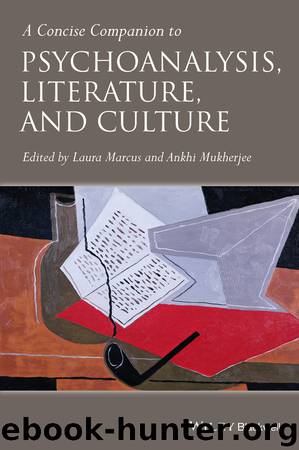A Concise Companion to Psychoanalysis, Literature, and Culture by Marcus Laura Mukherjee Ankhi & Ankhi Mukherjee

Author:Marcus, Laura, Mukherjee, Ankhi & Ankhi Mukherjee
Language: eng
Format: epub
ISBN: 9781118610220
Publisher: Wiley
Published: 2014-05-02T00:00:00+00:00
Chapter 12
Psychoanalysis, Popular and Unpopular
Catherine Liu
In the 1956 science fiction film Forbidden Planet, a dashing crew of terrestrial soldiers frees a fair maiden and destroys an alien machine that can unleash the destructive power of the “id.” Leslie Nielsen, playing the captain of the United Planets Cruiser C57-D, triumphs over the hubristic mad genius Dr. Morbius by forcing him to accept that the invisible monster that killed all members of his original expeditionary force was a materialization of his own “subconscious.” Morbius, played by Walter Pidgeon, has been living with his daughter Alta in a modernist, biomorphic-style ranch house in a state of radical seclusion and incestuous self-sufficiency. Psychoanalytic terms like “id” were common currency in Hollywood of the 1950s: long before 1970s film theorists embraced sexual difference, the gaze, and fetishism as keys to understanding film form, spectatorship, and the ideological apparatus, the American film industry followed in the footsteps of Greenwich Village bohemian modernists by taking up the tools presented by Sigmund Freud’s epochal discovery.
In narrativizing, visualizing, and taking apart the psychic apparatus on screen, Hollywood filmmakers and stars displayed their embrace of modern life: Forbidden Planet not only cast the psychoanalytic concept of the “id” as its villain, it was also the first feature film with a completely electronic score, composed by experimental musicians Lois and Bebe Baron. Dr. Morbius’ home on Altair bears a striking resemblance to the intimate but modern case-study homes being built in California by a generation of idealistic architects, from Charles and Ray Eames to Gregory Ain. Its furnishings follow the biomorphic designs of Isamu Noguchi, while Robbie the Robot as futuristic butler incarnates the domestic labor-saving device in one compact, queer anthropomorphic package. Finally, under Leslie Nielsen’s, or Commander John Jay Adams’, insistence, Morbius acknowledges, like a good psychoanalytic patient, his dark side: he accepts that the monster is a materialization of his unconscious aggression. In order to save the world from its nefarious power, he, like the Krell technology, must be destroyed. The massive power plant, suggested by special effects produced by painted sets – implying a vast underground lair – must be laid waste, lest other creatures come into contact with its mysterious ability to realize one’s unconscious aggressions. His daughter Alta is released from her incestuous sequestration and the expeditionary force can return to Earth having solved the riddle of Morbius’ failure and self-destruction. The unconscious, once weaponized, can have genocidal powers: its containment is the task of a rag-tag detachment of Earth soldiers, whose respect for the chain of command allows the highest-ranking officer to win the love of the innocent daughter of an alien world. Working between high culture and pulp fiction, the film is able to refer to Shakespeare and Freud while providing an MGM showcase for Disney animators, on loan to render the monster materialized out of Morbius’ unconscious.
According to Ann Douglas, Freud’s career and body of work shared a “mind-set and a mood” with white urban America: “Freud and America in the modern
Download
This site does not store any files on its server. We only index and link to content provided by other sites. Please contact the content providers to delete copyright contents if any and email us, we'll remove relevant links or contents immediately.
| Books & Reading | Comparative Literature |
| Criticism & Theory | Genres & Styles |
| Movements & Periods | Reference |
| Regional & Cultural | Women Authors |
4 3 2 1: A Novel by Paul Auster(12284)
The handmaid's tale by Margaret Atwood(7679)
Giovanni's Room by James Baldwin(7192)
Asking the Right Questions: A Guide to Critical Thinking by M. Neil Browne & Stuart M. Keeley(5635)
Big Magic: Creative Living Beyond Fear by Elizabeth Gilbert(5612)
Ego Is the Enemy by Ryan Holiday(5294)
The Body: A Guide for Occupants by Bill Bryson(4974)
On Writing A Memoir of the Craft by Stephen King(4863)
Ken Follett - World without end by Ken Follett(4645)
Adulting by Kelly Williams Brown(4487)
Bluets by Maggie Nelson(4474)
Eat That Frog! by Brian Tracy(4435)
Guilty Pleasures by Laurell K Hamilton(4360)
The Poetry of Pablo Neruda by Pablo Neruda(4039)
Alive: The Story of the Andes Survivors by Piers Paul Read(3968)
White Noise - A Novel by Don DeLillo(3954)
Fingerprints of the Gods by Graham Hancock(3942)
The Book of Joy by Dalai Lama(3899)
The Bookshop by Penelope Fitzgerald(3775)
